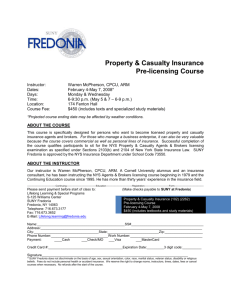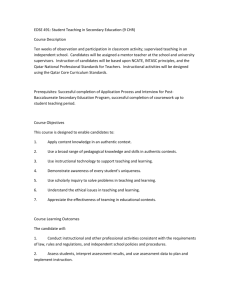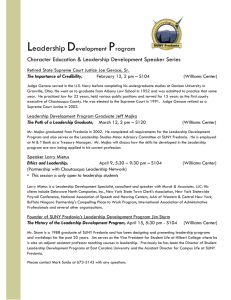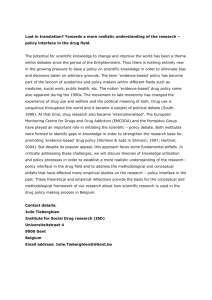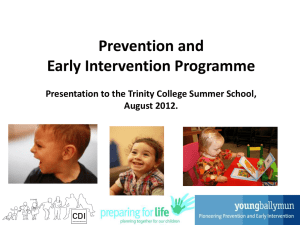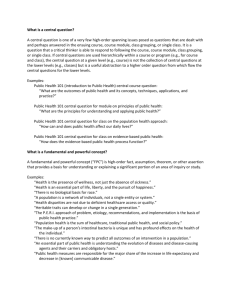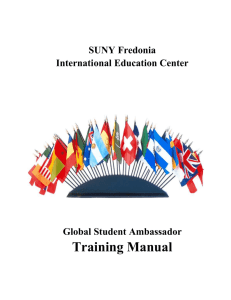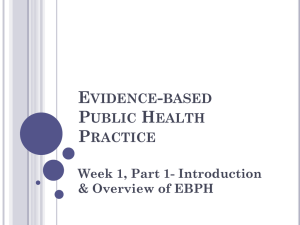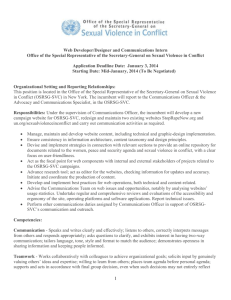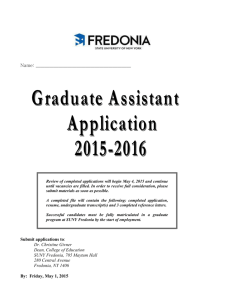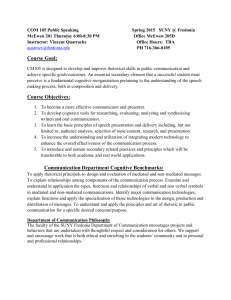Improving-clinical-practice-handout-1
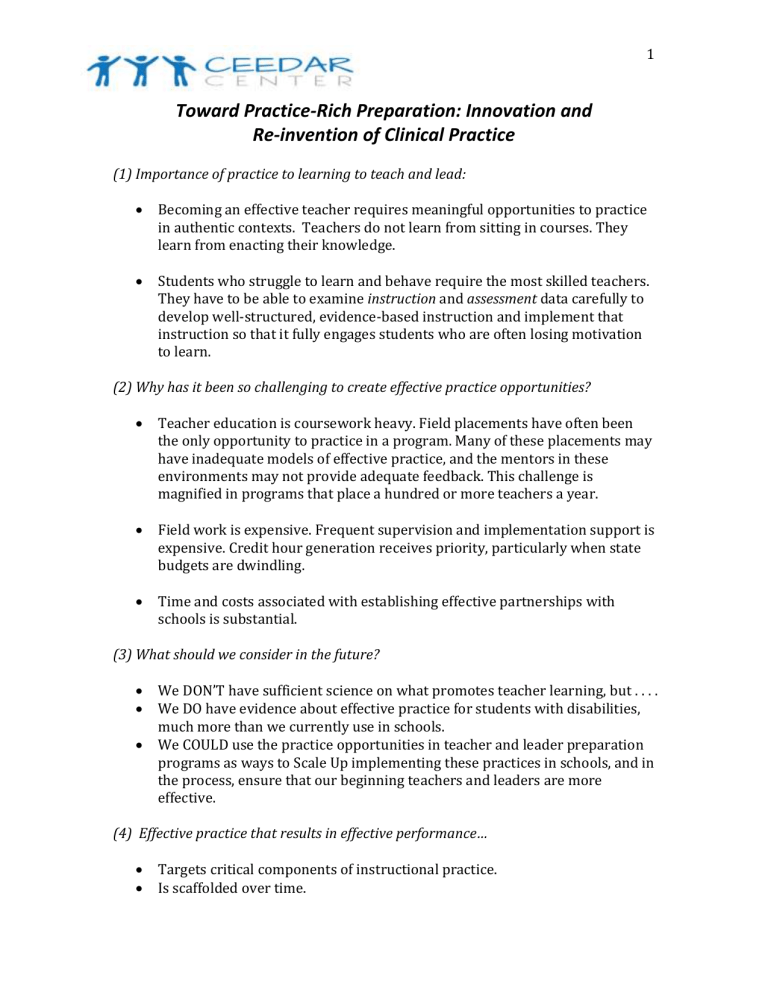
1
Toward Practice-Rich Preparation: Innovation and
Re-invention of Clinical Practice
(1) Importance of practice to learning to teach and lead:
Becoming an effective teacher requires meaningful opportunities to practice in authentic contexts. Teachers do not learn from sitting in courses. They learn from enacting their knowledge.
Students who struggle to learn and behave require the most skilled teachers.
They have to be able to examine instruction and assessment data carefully to develop well-structured, evidence-based instruction and implement that instruction so that it fully engages students who are often losing motivation to learn.
(2) Why has it been so challenging to create effective practice opportunities?
Teacher education is coursework heavy. Field placements have often been the only opportunity to practice in a program. Many of these placements may have inadequate models of effective practice, and the mentors in these environments may not provide adequate feedback. This challenge is magnified in programs that place a hundred or more teachers a year.
Field work is expensive. Frequent supervision and implementation support is expensive. Credit hour generation receives priority, particularly when state budgets are dwindling.
Time and costs associated with establishing effective partnerships with schools is substantial.
(3) What should we consider in the future?
We DON’T have sufficient science on what promotes teacher learning, but . . . .
We DO have evidence about effective practice for students with disabilities, much more than we currently use in schools.
We COULD use the practice opportunities in teacher and leader preparation programs as ways to Scale Up implementing these practices in schools, and in the process, ensure that our beginning teachers and leaders are more effective.
(4) Effective practice that results in effective performance…
Targets critical components of instructional practice.
Is scaffolded over time.
2
Provides high quality feedback on critical skills.
Improves ability to analyze and reflect one’s teaching and how student performance is changing as a result of using specific teaching strategies.
(5) Examples of effective practice-based opportunities in teacher education:
Well-structured field experiences tightly aligned with methods courses
SUNY Fredonia provides elementary education teacher well-structured opportunities to apply what they are learning in the classrooms in the field. Teacher candidates have opportunities to learn select evidence- based strategies in coursework and then field experiences are structured to enable them to practice the strategies. The field experiences begin with first year and second year teacher candidates working in pairs for 8 to 10 weeks in schools. They are instructional assistants, but they also have to teach two lessons where they implement an evidence-based practice. The second experience involves a small group, after school tutoring program.
They teach students an evidence-based cooperative learning strategy. To manage effectively the numbers of teacher candidates SUNY Fredonia has, they have students participate in a peer coaching experience. In this experience, they learn to coach each other on how they are using evidence-based practices. In each of these experiences, teacher candidates are encouraged to collect student assessment data, and use it to evaluate the effectiveness of their teaching. Each experience happens prior to entry into the internship; thus, by the time teacher candidates enter their internship, they have an expectation that they will continue to use evidence-based practice and collect student data. Plus, they know how to teach. To support the work, SUNY Fredonia faculty partner with teachers in the local schools that are using evidence-based practices. The teachers see the benefits of this approach to field work for their students so this helps the SUNY Fredonia school partnership.
Simulated teaching experiences that supplement clinical placement
TeachLivE is a simulated teaching experience, where a teacher candidate
(or a practicing teacher) teaches a virtual classroom to practice specific instructional skills, delivering specific content and effective instruction and classroom management skills. The virtual students have been programed with distinctive personality types, which means that in each simulation, they each display the same behavior patterns every time.
At
WMU, we use TeachLive as a supplement to our field experiences in “real” classrooms with “real” kids. TeachLive provides (a) opportunities for special education majors to practice essential skills that will be demonstrated in the practicum and/or internship settings, (b) opportunities for pre-intern and interns to focus on specific teaching
3 skills in need of further development, and (c) additional opportunities for targeted practice for pre-interns and interns who require more intensive coaching and focused attention in the execution of specific teaching skills.
Learn More: http://teachlive.org/
Yearlong residency programs that blend theory with practice while strengthening collaboration between universities and school districts
Boston Teacher Residency (BTR) is a one year, full-time AmeriCorps program that recruits and prepares Teacher Residents with the prerequisite skills needed to make an immediate impact in Boston Public School (BPS) classrooms. After an intensive two-month summer institute, each Resident is placed in a BPS classroom with a highly experienced collaborating teacher. In addition to receiving ongoing support and guidance from their collaborating teacher and BTR Clinical Teacher Educators, Residents study master’s-level coursework at the University of Massachusetts in pursuit of their initial teaching license and Master’s Degree. The BTR’s unique blend of theory and practice, combined with an emphasis on collaborative learning and peer support, gives Residents a field-tested foundation for success in an urban classroom as they become familiar with the state and local education agency goals.
Learn More: http://www.bostonteacherresidency.org/
State education initiatives that utilize technology in order to provide teachers with ongoing and high-quality lesson feedback.
In 2012, The New Teacher Project (TNTP) partnered with the Louisiana
Department of Education to enhance the state’s teacher evaluation system with a more comprehensive approach for providing teachers with ongoing, high-quality lesson feedback. TNTP developed a video library that districts can use to provide teachers with the meaningful feedback they need to refine their practices and meet the needs of all learners in the classroom.
Learn More: http://tntp.org/
(6) HEA regulations as they apply to clinical preparation
State approval requires evidence of quality clinical preparation. Quality clinical preparation must be: (a) provided, at least in part, by qualified clinical instructors who meet established qualification requirements and who use a training standard that is made publicly available, (b) include multiple clinical or field experiences, or both, that serve diverse, rural, or underrepresented student populations, including English language learners
4 and students with disabilities, and that are assessed using a performancebased protocol to demonstrate candidate mastery of content and pedagogy, and (c) require that teacher candidates use research-based practices, including observation and analysis of instruction, collaboration with peers, and effective use of technology for instructional purposes.
States must provide technical assistance for low-performing institutions. It can include identifying areas of curriculum or clinical experience that correlate with gaps in graduates’ preparation.
CEEDAR states have an advantage because they are already working on creating policies and reforming programs in ways that would improve clinical experiences to meet these definitions.
Learn More: https://www.federalregister.gov/articles/2014/12/03/2014-
28218/teacher-preparation-issues#p-190
(7) Future considerations
